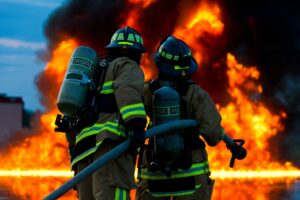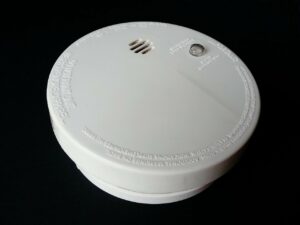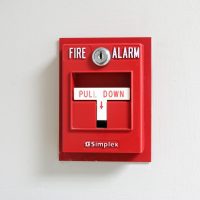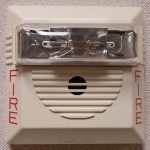If you’re a building owner, you’ll need a fire alarm in Houston. Building codes require fire alarm systems to help reduce the risk to life and property from fires. It’s critical to design the right system for your commercial building, both for compliance and for safety. Our professionals can help guide you through this process and create a system designed for your building. In this article, we’ll discuss some of the main points of creating a commercial fire alarm system that meets code requirements and your building’s specific needs.
The Necessity of a Commercial Fire Alarm in Houston
You probably know that fire alarms are required for commercial buildings. For instance, they’re mentioned in international building codes as well as in municipal building and fire codes. Alarms are essential for life safety, as they can help detect fires and alert people to evacuate. Early detection may even help reduce property damage, as you can call the fire department as soon as possible after a fire breaks out. Many alarm systems also include fire suppression systems in Houston to help control or extinguish fires as well, which can also help minimize risks to life and property.

Consider Different Hazards When Designing Your Fire Alarm in Houston
Now, just because they’re called “fire alarms” doesn’t mean that they only help with fires. Most modern systems are integrated lifesafety solutions designed to help with a lot of different hazards. So, when designing your system, our experts will talk with you to determine what risks exist and how your system may help with these different situations.
Carbon Monoxide
Practically every fire alarm in Houston today also includes carbon monoxide detection and alarms. Carbon monoxide is a dangerous gas that is released when fuel burns incompletely. Therefore, most commercial buildings have some risk of carbon monoxide poisoning, such as from a water heater. A sophisticated fire and life safety system will include CO detection as well as alarms to help evacuate the building in case of toxic levels of carbon monoxide gas.
Other Lifesafety Issues
Let’s not forget other lifesafety concerns as well. Alarms can also help notify occupants of different hazards, such as severe weather alerts, active shooters, or other lifesafety issues. The key is to determine what kinds of risks your facility has. For instance, schools and assembly areas might have a higher risk for active shooters, while an industrial facility might be more at risk for toxic gases. Whatever the case, alarms are essential for alerting people to potential dangers.
Components of a Fire Alarm in Houston
There are many different components to commercial fire alarm systems. Your fire safety professional can help you choose the right components to fully customize the system to your needs.
At the very least, most commercial buildings need a fire system that includes fire detection, audible and visual alarms, as well as some type of fire suppression. Which components you need usually depends on what you use your building for. For instance, business/mercantile, education, or assembly. Your specific fire safety concerns will also play a part.
Some common components you might find in a fire alarm system include:
- Fire detectors
- CO detectors
- Hand pull stations for manual alarm triggering
- Horn/strobe alarm devices
- Fire suppression systems in Houston
- Mass notification systems
Fire Detectors
For an alarm to sound, there obviously needs to be something that detects the fire in the first place. This is where fire detectors come into play for your system. There are four main types of fire detectors that you might use in your facility: ionization, photoelectric, heat, and ionization/photoelectric detectors.
Ionization smoke detectors have a constant electrical current running between two plates inside. When smoke from a fire reaches the detector, it disrupts the current. The detector then sends a signal to the alarm control panel to start sounding the alarm that people should evacuate.
Photoelectric smoke detectors work very similarly to ionization smoke detectors. The difference is that, instead of an electrical current, there’s a constant beam of light that smoke interrupts, which is how the device detects a fire.

Heat detectors are another type of fire detection device you might use in your fire alarm system. This is exactly as it sounds: it detects temperature changes that indicate a fire. Typically these have longer reaction times, so they’re better used in less frequently occupied buildings like storage facilities and warehouses.
Another common smoke detector option is an ionization/photoelectric detector. These use both photoelectric and ionization properties to help detect smoke from a fire. Many people believe these are the best types of smoke detectors because they’re the best of both worlds for smoke detection.
CO Detectors
As we mentioned, it’s common to include carbon monoxide detection in your fire alarm in Houston. In many cases, smoke detectors will also have CO detection included. In other cases, you may choose to have separate detectors for CO and smoke. Typically, your alarm system will make a different noise for dangerous carbon monoxide levels than for a fire. For instance, the standard fire sound includes three repeating noises (such as a beep, horn, ringing, or other loud alarm), while carbon monoxide typically has four repeating noises to help distinguish between different emergencies.
Hand Pull Stations
In addition to detectors, in most buildings you also need at least one hand pull station. A hand pull station is a way to manually start the fire alarm. This is useful because smoke can take several minutes to reach smoke detectors. If someone in the building sees a fire, they can pull the handle to start the alarm immediately for early evacuation. This allows for early detection, which is incredibly valuable. Even a few extra seconds can make a difference for evacuation and alerting the fire department.

Horn/Strobe Devices
This is probably what you think of when you think “fire alarm.” Horn/strobe devices are the parts of the commercial fire alarm system that actually alert people to the fire. Horn/strobe devices provide both audible and visual alerts that there is a fire. They emit a high volume alarm sound as well as strobing lights for those who may not hear the alarm, like the hard of hearing.

Fire Suppression Systems in Houston
In addition to alarms, your system will likely also include a suppression system. While the other devices are meant to alert someone to a fire, these are designed to help extinguish the flames. Once a fire is detected in the building, fire suppression devices release a suppressing agent, like water, foam, or gases, meant to help extinguish, reduce, or otherwise control the fire. This can help reduce life safety risks as well as property damage from the fire.
Mass Notification Systems
Another component to include for your fire alarm in Houston is a mass notification system. Mass notification systems are required in some buildings, typically based on occupancy numbers. However, many building owners are installing them even if they’re not currently required by fire codes. This is because these systems may help improve evacuation response to fire and life safety alarms.
You might think that a horn/strobe device would make people realize there’s a fire. However, studies show that people are often slow to react to fire alarms.
Here are some reasons people may not respond to a fire alarm:
- People can’t hear the alarm
- They don’t realize the alarm signals a fire
- They believe it’s a false alarm, test, drill, or other non-emergency
Poor system design is usually to blame when people can’t hear the alarm. For instance, devices that are too far apart or with the volume set too low. However, the other two reasons people ignore fire alarms are really concerning. Mass notification systems help provide a pre-recorded message to occupants to let them know that there is a fire, it’s not a drill, and that they need to evacuate immediately. Many commercial building owners are making the switch to mass notification systems, also known as voice evac systems because of this.
Another great benefit of mass notification systems is they can explain exactly what the emergency is. We mentioned earlier that you can design your system to address more than just fires. Mass notification systems provide information on exactly what the emergency is and how to respond. For instance, for an active shooter situation, it may be safest to shelter in place rather than evacuate the building. Mass notification systems can give this information to building occupants.
Fire and Lifesafety Solutions at Wilson Fire Equipment
At Wilson Fire, we’ve been protecting people and property since 1916 with innovative solutions for fire safety, life safety, and security. We design, install, monitor, and service a wide range of systems to help you keep your building and its occupants safe. Whether you need a new fire alarm system with more modern equipment or need expert inspections and maintenance for compliance, our team is here to serve you. Call us now at (713) 896-4747 to get a free quote or to schedule service!
